How Smart Teams Use Layered Data to Drive Better Content Decisions
Smart content decisions don’t come from instinct alone. The most effective teams layer data signals like search intent, brand visibility, and audience feedback to guide strategy and secure stakeholder buy-in. This article breaks down how to combine intuition with evidence to create content that resonates and drives measurable impact.

Many content specialists rely on instinct to pitch ideas.
Think editorial judgment, audience empathy, and leadership preferences.
Sometimes it works brilliantly. Other times, you spend months creating content nobody wants.
The truth?
Gut feeling alone isn't enough anymore.
Smart content teams are using both instinct and data to make decisions that actually stick
Here's how they're doing it.
Why instinct alone isn’t enough
Long story short: economic pressure is forcing content teams to justify every decision.
Budgets are getting slashed. Layoffs hit marketing teams first.
AI tools can pump out generic articles in minutes, making leadership question why they need human specialists and writers at all (which is very wrong, if you ask me).
At the same time, the zero-click environment means your best content might build brand awareness and drive leads without attracting direct traffic.
All this creates a measurement gap that pure instinct can't bridge.
However, the solution isn't tying every blog post to direct revenue. Content doesn't work like paid ads.
Instead, you need tracking across multiple dimensions: brand awareness, pipeline influence, AI visibility, social engagement, etc.
The data layers that strengthen content decisions
Let’s explore the key data signals you can use: search intent, brand awareness metrics, social media metrics, conversions, and audience feedback loops.
Search intent signals
Search intent data shows you which content ideas have real audience demand before you start writing.
Here’s how you can shape your analysis:
- Question mapping: Go where your customers actually ask questions — on sales calls, Reddit threads, Quora, or in customer support tickets. Record the exact phrases they use and prioritize these topics when planning content.
- Keyword validation across platforms: Compare Google keyword volumes (via Semrush’s Keyword Magic Tool) with ChatGPT search trends (via the AI SEO Toolkit) to find topics that work in both traditional SEO and AI search.
- Content gap analysis: Check the existing content for your priority topics and keywords. Search your target keywords in Google, then ask the same questions in ChatGPT. If ChatGPT gives generic, surface-level answers while Google shows thin competitor content, you've found an opportunity to create something deeper and more useful.
For example, Semrush’s sales specialists kept hearing "Will Google penalize my AI-generated content?" from prospects evaluating our AI writing tool.
I used Semrush to check whether there was any search volume for related queries — such as “Does Google penalize AI content?” and “Can AI content rank?”
It turned out that people are indeed searching for these keywords:

Then I looked at the top-ranking content on Google and on AI platforms such as ChatGPT and Perplexity.
Everything was speculation without any concrete data.
So, we analyzed 20,000 articles and published research on whether AI content can rank on Google.
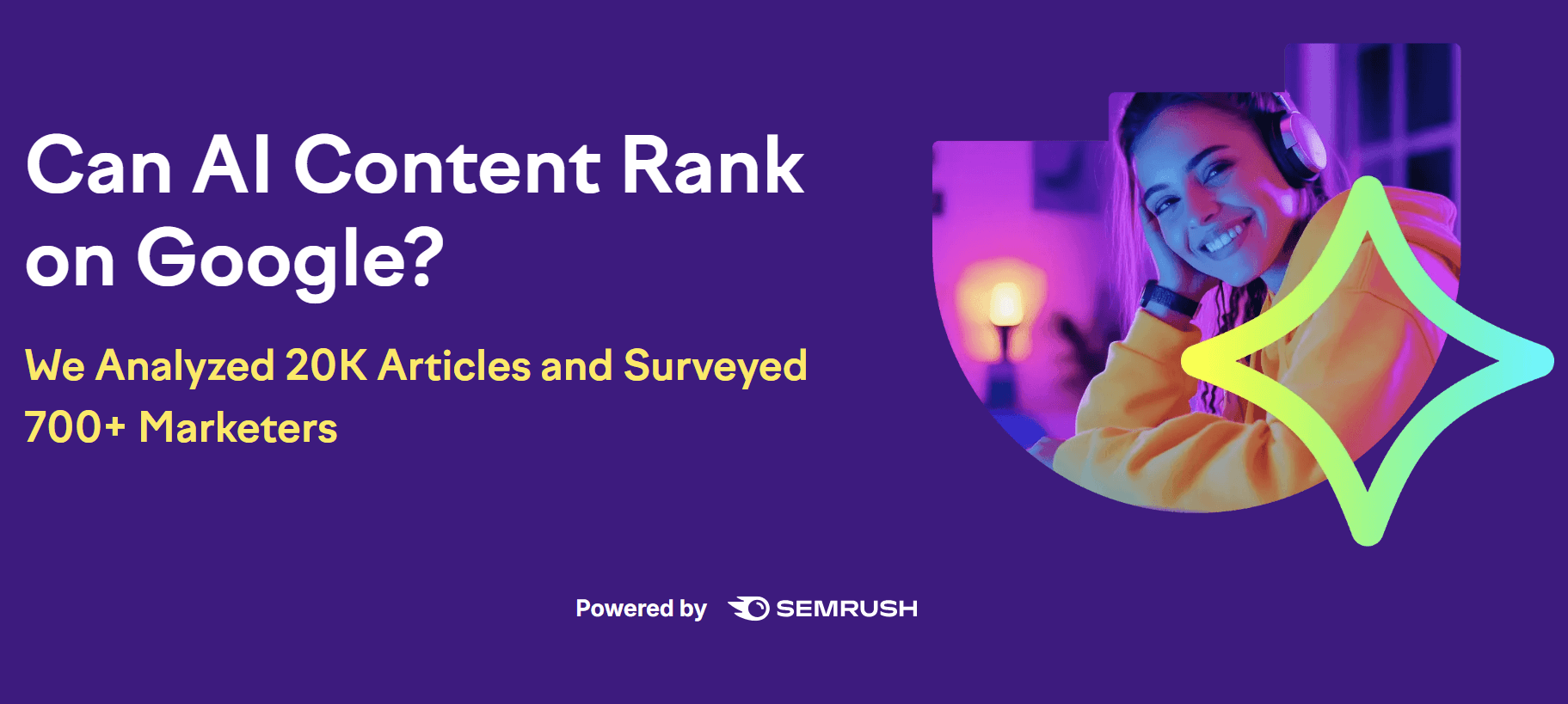
The result?
Our piece ranks high both on traditional SERPs:

And in AI chatbots, attracting high-intent users and helping us address key blockers in the buying process.

Brand awareness metrics
Brand awareness metrics reveal whether your content is building recognition and trust, even when it doesn't drive direct traffic.
I’ve always believed that one of content’s key roles is exactly this: helping businesses connect with customers.
Here’s how you can approach this:
- Sentiment tracking: Monitor how people talk about your brand across social platforms and forums by using a tool like Brand24.
- Branded search growth: Watch for increases in people searching directly for your company name and see whether it correlates with recently published content via Google Search Console.
- Share of voice: Measure your brand's presence in industry conversations relative to competitors (Brand24 is also my go-to tool for this).
- AI brand mentions: Track how often AI tools mention your brand versus competitors when users ask relevant questions using tools like Semrush’s AI SEO Toolkit.
- AI citation frequency: Analyze how often your content or research is cited as a source in AI-generated answers, which can also be done via the AI SEO Toolkit.
In fact, AI visibility is a major opportunity for justifying content marketing investment today — whether to stakeholders or clients.
For example, Chargeblast (a Semrush client) has seen a downward trend in organic traffic, a challenge many websites are facing.

However, after a short analysis, I noticed that the AI traffic has been rapidly growing — also typical these days.

At the same time, the brand’s AI visibility leaves a lot to be desired: according to Semrush data, its score is only 1 out of 100.

This highlights plenty of opportunities, making AI share growth a key area to focus on, which is exactly what the brand’s marketing team has prioritized for this year.
Social media engagement metrics
Social engagement patterns predict which content formats and topics will drive business results.
Social media is also a powerful channel for generating leads and conversions — not just for B2C and ecommerce brands, but also for B2B.
For example, David Baum, Relato’s CEO, relies on LinkedIn as a steady source of qualified leads.
“I post and engage consistently on LinkedIn every weekday. There, I share my perspectives on our industry, the views of our team, and I also promote fresh content, product updates, and news. This activity contributes directly to 10 – 15 customer meetings a week (intros, discovery, and demos).” — David Baum, Co-Founder and CEO at Relato
Here are the key signals to look out for:
- Professional relevance signals: Saves, shares, and comments from your ideal buyers.
- Community validation: Reddit upvotes and meaningful discussions in relevant subreddits, as well as messages and overall sentiment on other community platforms.
- Direct relationship building: DMs and connection requests generated by specific content pieces.
- Amplification potential: Content that resonates so strongly with your team and customers that they naturally share it, extending engagement and reach.
Industry experts like Evan Knight, Founder of Thoughtful Content, also stress that sharing thought leadership content can directly drive pipeline growth:
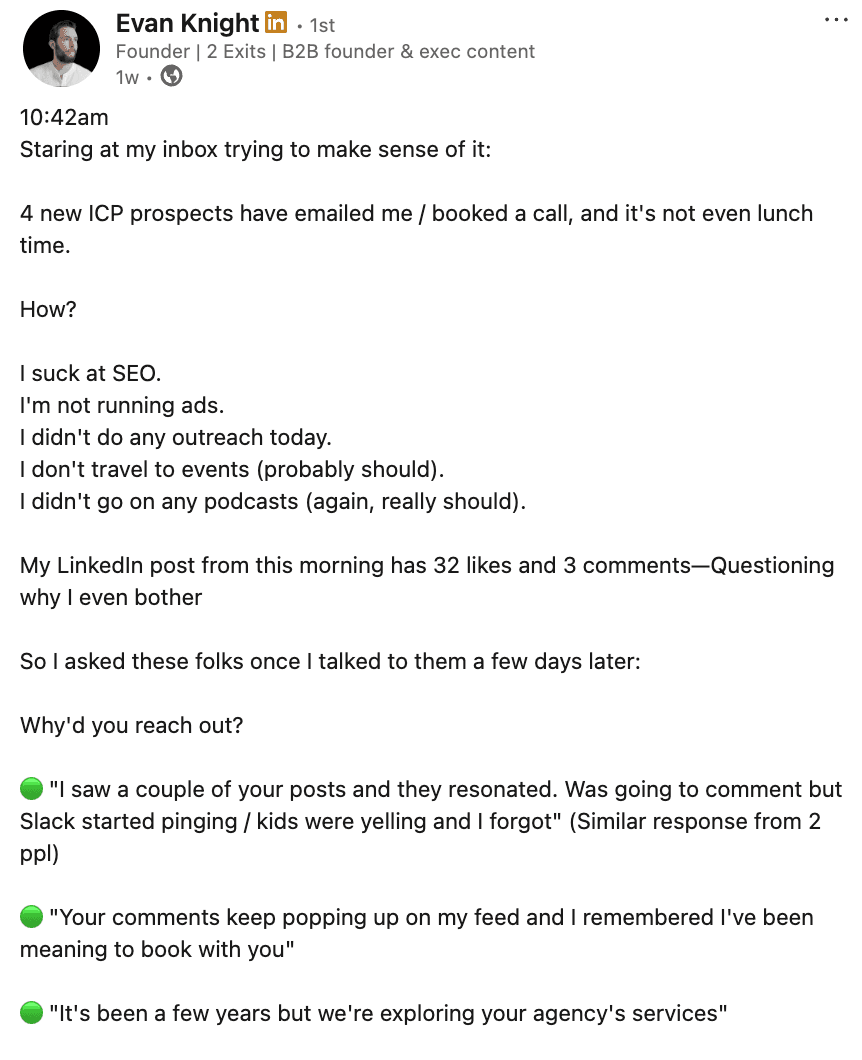
Audience feedback and closed loops
Audience feedback signals show whether your content strategy aligns with customer needs and market conversations.
These qualitative signals complement your quantitative data by revealing gaps between what you think your audience wants and what they actually need.
Here’s what you can measure:
- Sentiment around your content: Use Brand24 to monitor when people discuss your brand and content topics. For example, you can track keywords like "blog" or "guide" alongside your brand name to catch content references. Then, review the context and see if mentions are positive, neutral, or negative.
- Engagement quality indicators: Compare the length and depth of discussions around your content — whether on your blog, social media, or forums. Track if people ask follow-up questions, share personal experiences, or challenge your points.
- Follow-up question patterns: Create a simple form for sales and support teams to log what additional questions people ask after consuming specific content pieces.
- Content sharing context: Monitor social media to see how people describe your content when they share it. The added context reveals whether it genuinely resonated and why.
For example, I always carefully read LinkedIn posts referencing my content — and the feedback users leave in the comments.
In this post, Natalia reshared a recent article with AI visibility tips:
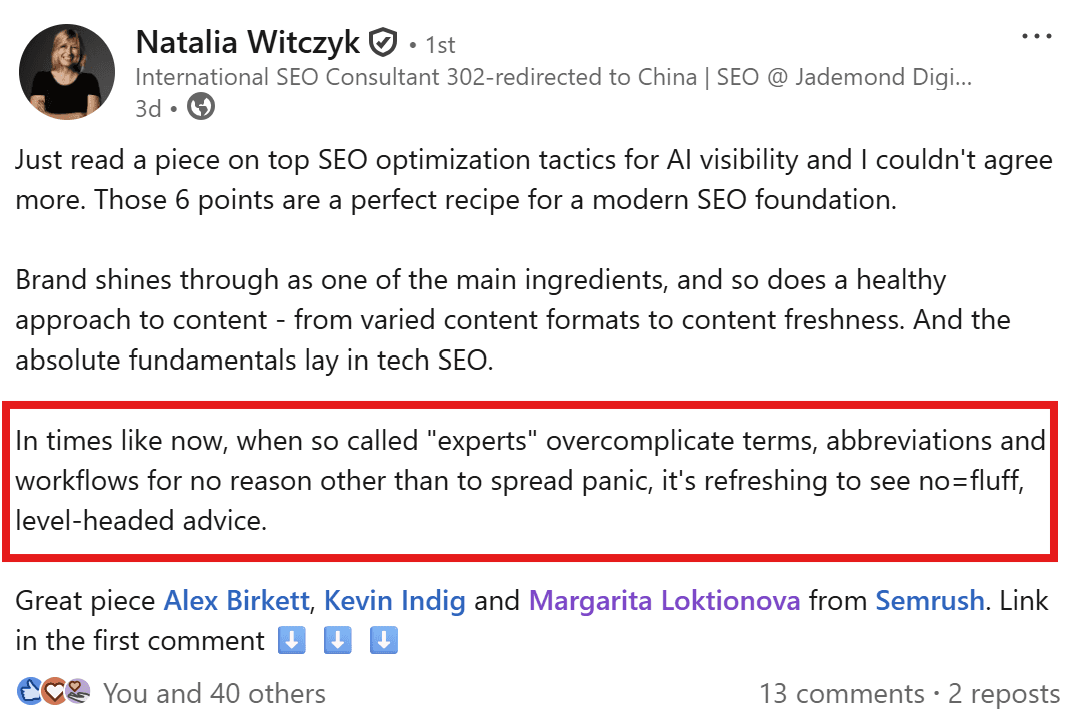
My takeaway?
The article stands out because it’s simple, grounded, and fluff-free compared to the alternatives.
That highlights an important differentiation point in our niche that I’ll continue to use for my content.
Content performance data
While not every content piece will directly drive revenue metrics, tracking its overall contribution and ROI is always a good idea.
This is especially important for product-led, sales enablement, and other bottom-of-the-funnel content.
For example, you can track:
- Assisted conversions: Track which content pieces contribute to conversions like leads, trials, and purchases using multitouch attribution, since most content nurtures prospects through the buying journey rather than driving immediate purchases.
- Pipeline velocity correlation: Measure how prospects who engage with specific content move through the funnel and make sure your sales team logs the sales enablement assets they use in the CRM.
- Sales team content usage: Monitor which resources your sales team shares most often in demos and follow-up calls. Track which assets prospects request or reference during conversations using CRM notes, call recordings, or analytics from tools like Seismic.
- Content influence on deal size: Analyze whether prospects who engage with certain content pieces (like case studies, ROI tools, or implementation guides) close with higher contract values than the baseline average.
How to combine insights & instinct
The most effective content decisions happen when data validates opportunities and instinct shapes the creative execution.
Let’s map out a workflow that connects both worlds.
Use signals to shape your approach
Start with the insights you've collected: search intent showing demand, brand awareness metrics revealing market gaps, and social engagement patterns highlighting what resonates.
These signals point you toward content opportunities that have genuine audience interest behind them — and real potential.
Then, apply your editorial judgment to find angles competitors haven't explored.
The data gives you a direction, but it’s up to you to find the fresh angles, unique stories, or underexplored perspectives that competitors haven’t tapped into yet.
Build systematic data collection workflows
Next, bring the signals you’re already collecting into one shared workspace.
If you’re using Relato, you can connect your Google Search Console account to see which pages are gaining visibility, earning impressions, or trending upward across your library. This gives you a clear view of what's resonating in search without digging through spreadsheets.
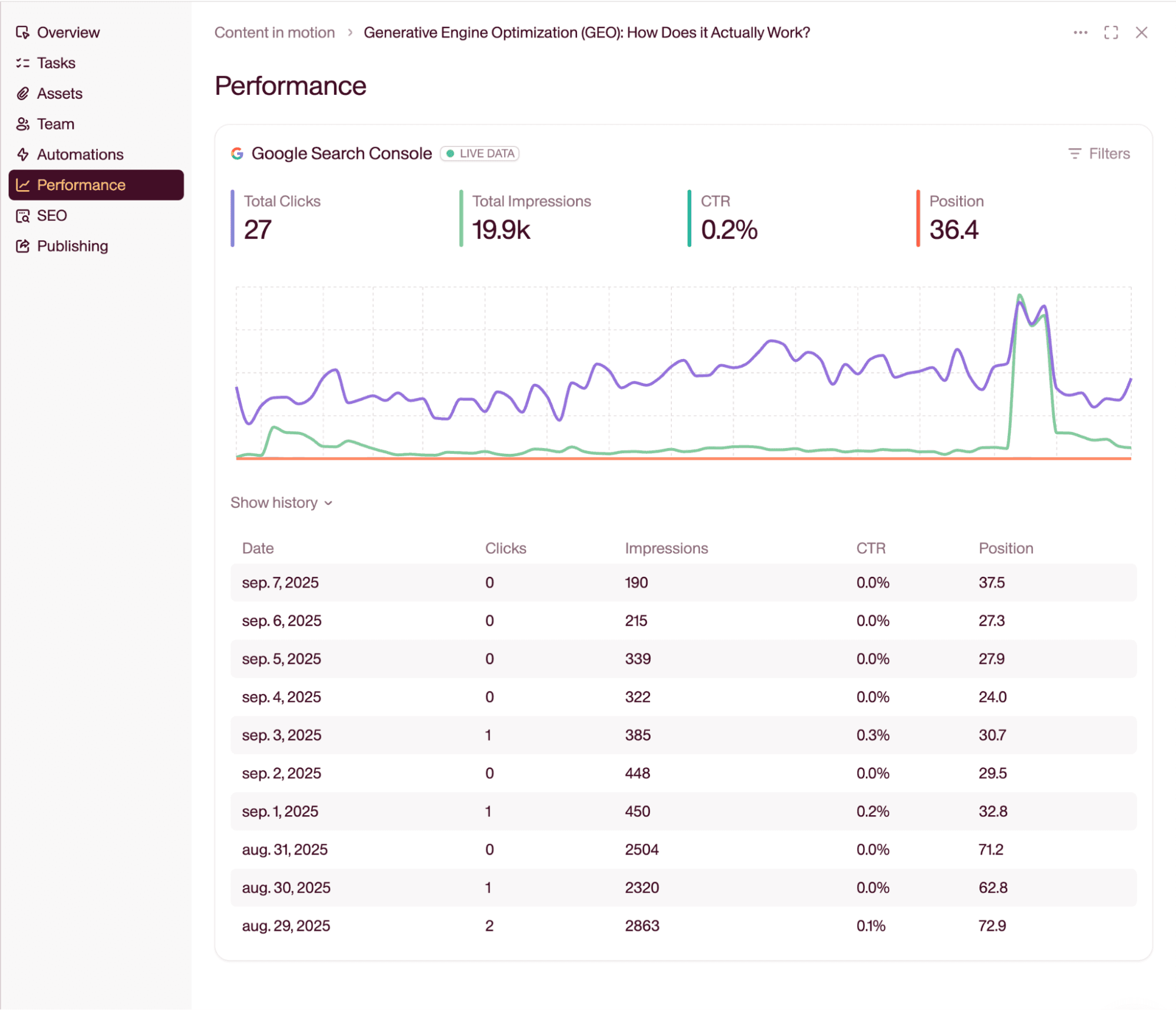
From there, you can add snapshots of key social engagement metrics and performance data (even if it's tracked manually or pulled from native analytics tools).
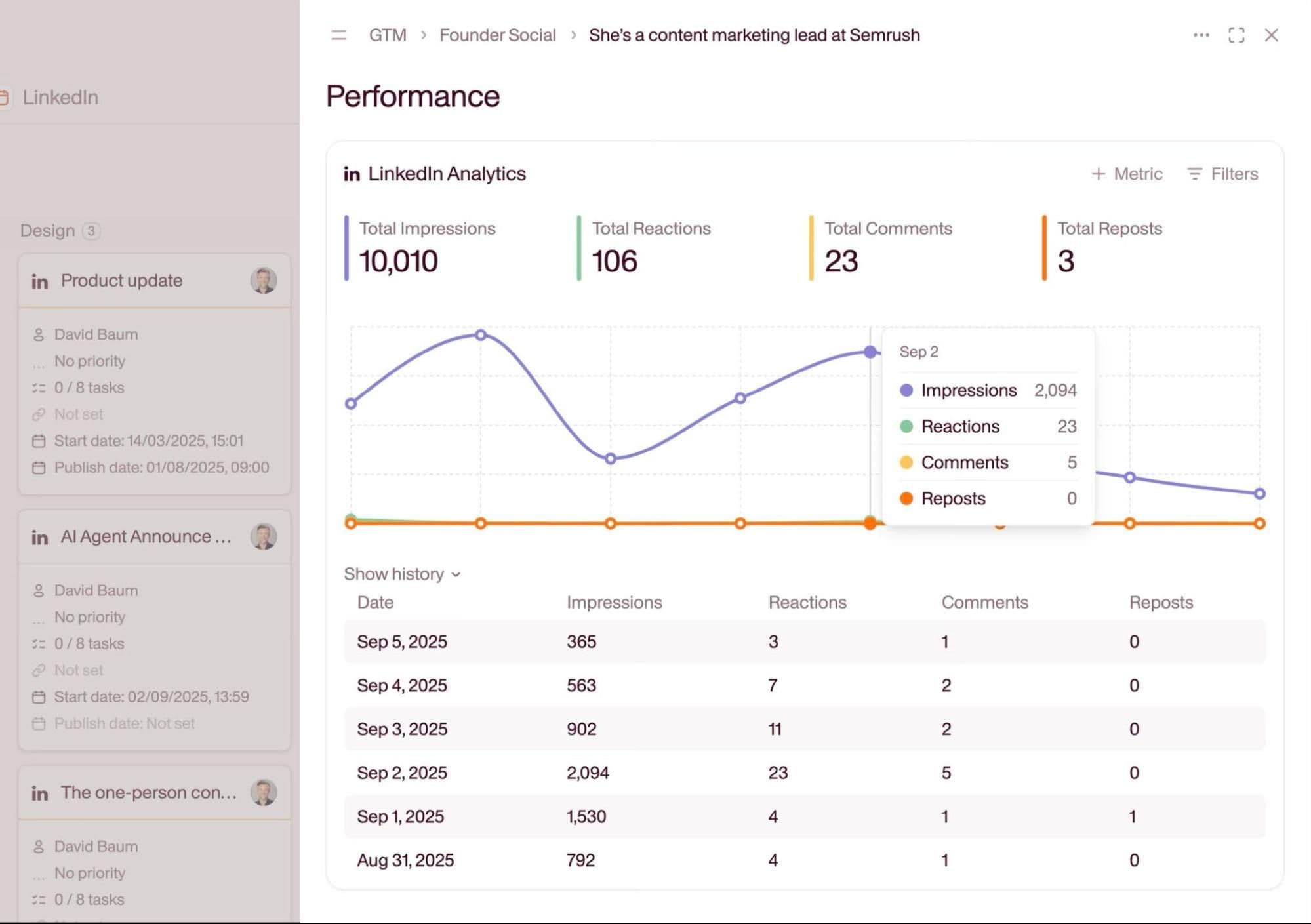
The goal isn’t to replace the tools you use — it’s to review these signals together, in context, with your editorial and GTM teams.
Once you have a shared view of search lift, social resonance, and qualitative feedback, schedule a simple weekly editorial review.
Look for:
- Topics that appear across multiple channels
- Formats that consistently perform well
- Content that surfaces in sales conversations
These recurring patterns become your clearest strategic signals.
Use data to make the story complete
Finally, turn validated opportunities into compelling pitches by building mini business cases that combine creative insight with hard evidence.
This approach helps secure stakeholder buy-in (and budget) while giving you more confidence in planning content.
Here’s how:
- Lead with the hook, back with proof: Start with the narrative that captures attention, then support it with converging data points from multiple sources.
- Show business impact: Connect content performance to pipeline velocity, deal size, or other metrics leadership cares about.
- Create feedback loops: Track which data-backed predictions actually delivered results to improve future pitch accuracy.
For example, when justifying a content idea, pitch something like:
"Our sales team reports that customers hesitate to purchase our AI writing tool because they worry Google will penalize their websites. We're seeing over 100 monthly searches for related keywords like “Does Google penalize AI content” — low volume but high intent, and we expect it to grow. We've also noticed frequent discussions on LinkedIn and Reddit with people asking questions and sharing speculation about this topic. We propose conducting original research to determine if Google actually penalizes AI-generated content, then creating content that attracts search traffic, generates social media engagement, and directly addresses our biggest sales objection — helping us attract more leads and close deals faster."
Then list the specific metrics you want to track — such as lead volume and pipeline impact — and report how your content performs against them.
Common pitfalls and how to avoid them
Measuring content performance may look simple on paper, but in practice, it’s anything but.
Teams need to connect various data sources, justify the importance of non-revenue metrics to stakeholders, and interpret the multidimensional insights they collect.
Here are some of the most common mistakes that slow down this process — and ways to address them:

For example, earlier this year, we hosted an AI visibility webinar together with Emilia Moller, a LinkedIn expert.
The response was impressive: over 2.5k registrations, extremely positive feedback, lots of LinkedIn engagement, and plenty of questions asked during the session.

However — as is often the case with high-level content — we couldn’t track many direct product payments. And of course, stakeholders don’t tend to prioritize webinar engagement metrics.
So, we framed the story around these points:
- The number, intent, and sentiment of product-related comments and questions posted during the webinar
- Traffic to the tool via the UTM link shared during the session
- Post-webinar LinkedIn publications made by attendees, amplifying Semrush’s thought leadership
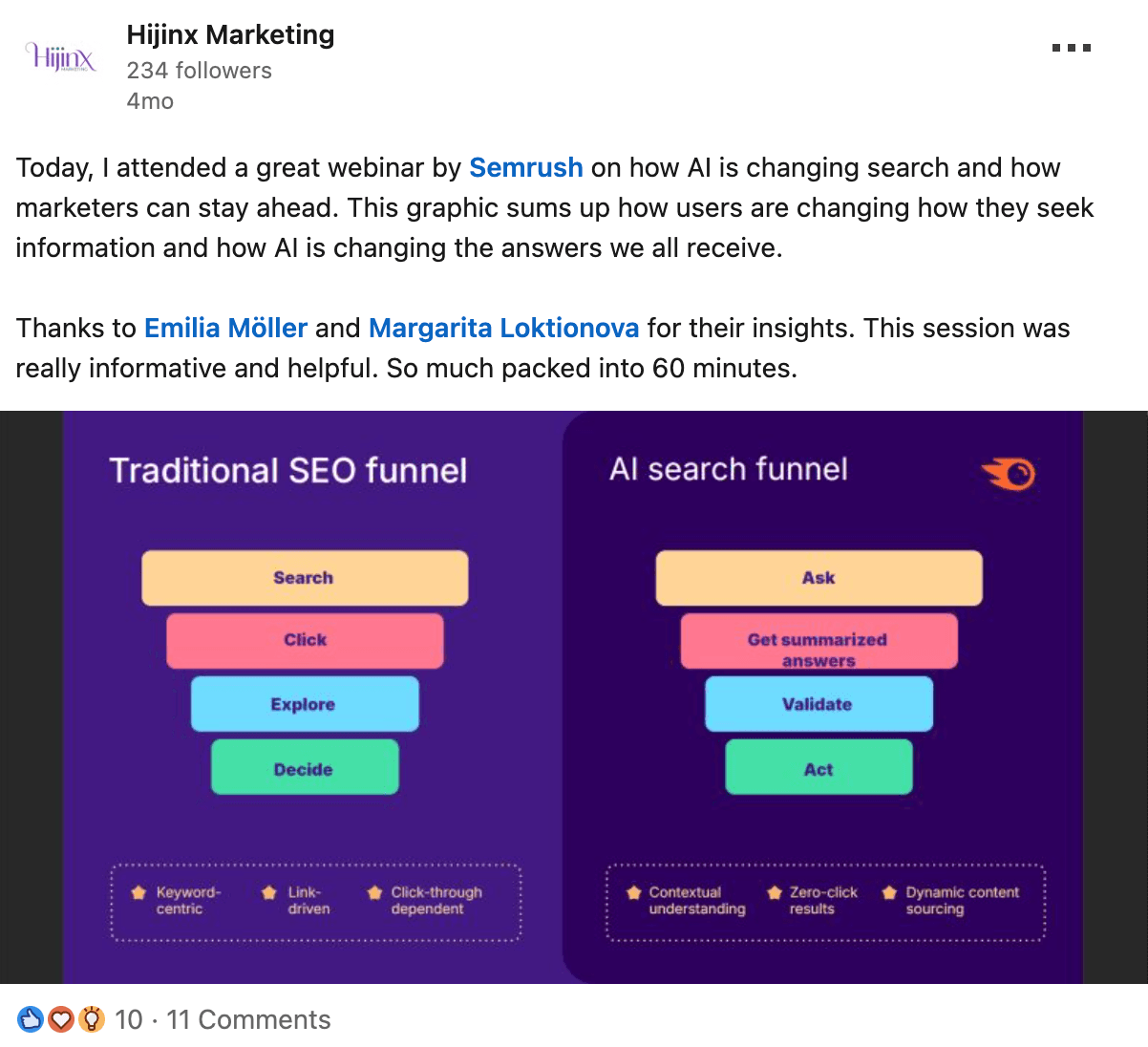
This shows how gathering feedback and data from different sources helps us analyze and demonstrate the value of content.
The most valuable insights emerge when your signals live in one place.
Relato helps content teams see what’s working — and why — so it’s easier to pitch confidently, plan strategically, and move faster.